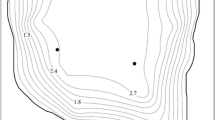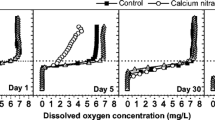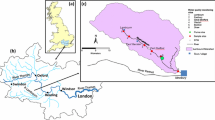Abstract
Cultural eutrophication has promoted the application of several mitigation strategies in the last 50 years. In this study we tested the combined effects of two techniques: calcium hydroxide [(Ca(OH)2), lime] and a free-floating macrophyte (Salvinia rotundifolia Willd) to examine the soluble reactive phosphorus removal capability and the effects on plankton (phytoplankton and zooplankton) structure in a in situ lake mesocosms experiment. The experiment lasted 10 days (n = 12, 500 l each) with a control and three treatments (lime (CH), plants (FM), and the combination of both (CH + FM)). Samples of several physical and chemical variables (including nutrients) and phytoplankton were taken at the beginning, 2 days after, 4 days, and 10 days (end of the experiment). Zooplankton was sampled at the beginning and at the end. The highest depletion effect of soluble reactive phosphorus (SRP) was observed in presence of lime. Phytoplankton biovolume was highly and negatively affected in lime treatments (CH and CH + FM). Zooplankton changed from Rotifera to Cladocera and Copepoda in presence of macrophytes. We conclude that lime + plants reduces more effectively SRP, phytoplankton biovolume and promotes herbivorous zooplankton development; becoming by this way, in a suitable mitigation strategy to be explored in future field manipulation studies.






Similar content being viewed by others
References
APHA, 2005. Standard methods for the examination of water and wastewater, 21st ed. American Public Health Association, Washington, United Stated.
Alekseev, V. R., 2002. Copepoda. In Fernando, C. H. (ed.), A Guide to Tropical Freshwater Zooplankton. Backhuys Publication, Kerkwerve: 123–188.
Babin, J., E. E. Prepas, T. P. Murphy & H. R. Hamilton, 1989. A Test of the Effects of Lime on Algal Biomass and Total Phosphorus Concentrations in Edmonton Stormwater Retention Lakes. Lake and Reservoir Management 5: 129–135.
Bakker, E. S., J. M. Sarneel, R. D. Gulati, z Liu & E. van Donk, 2013. Restoring macrophyte diversity in shallow temperate lakes: biotic versus abiotic constraints. Hydrobiologia 710: 23–37.
Bicudo, D. C., B. M. Fonseca, L. M. Bini, L. O. Crossetti, C. E. Bicudo & T. Araujo-Jesús, 2007. Undesirable side–effects of water hyacinth control in a shallow tropical reservoir. Freshwater Biology 52: 1120–1133.
Carey, C. C., B. W. Ibelings, E. P. Hoffmann, D. P. Hamilton & J. D. Brookes, 2012. Eco-physiological adaptations that favour freshwater cyanobacteria in a changing climate. Water Research 46: 1394–1407.
Copetti, D., K. Finsterle, L. Marziali, F. Stefani, G. Tartari, G. Douglas, K. Reitzel, B. M. Spears, I. J. Winfield, G. Crosa, P. D’Haese, S. Yasseri & M. Lürling, 2016. Eutrophication management in surface waters using lanthanum modified bentonite: A review. Water Research 97: 162–174.
Debusk, D. F. & K. R. Reddy, 1987. Growth and nutrient uptake potential of Azolla caroliniana Willd and Salvinia rotundifolia Willd as a function of temperature. Environmental and Experimental Botany 27: 215–221.
Dhote, S. & S. Dixit, 2009. Water quality improvement through macrophytes – a review. Environmental Monitoring Assessment 152: 149–153.
Dittrich, M. & R. Koschel, 2002. Interactions between calcite precipitation (natural and artificial) and phosphorus cycle in the hardwater lake. Hydrobiologia 469: 49–57.
Gaudet, J. J. & D. B. Koh, 1968. Effect of Various Growth Regulators on Salvinia rotundifolia in Sterile Culture. Journal of the Torrey Botanical Club 95: 92–102.
Gulati, R. D., L. M. D. Pires & E. van Donk, 2008. Lake restoration studies: failures, bottlenecks and prospects of new ecotechnological measures. Limnologica 38: 233–247.
Hammer, Ø., D. A. T. Harper & P. D. Ryan, 2001. PAST: Paleontological Statistics Software Package for Education and Data Analysis. Palaeontologia Electronica 4: 9.
Hillebrand, H., C. Durselen, D. Kirschtel, U. Pollingher & T. Zohary, 1999. Biovolume calculation for pelagic and benthic microalgae. Journal of Phycology 35: 403–424.
Huser, B., S. Huser, H. Egemose, H. Harper, M. Hupfer, H. Jensen, K. M. Pilgrim, K. Reitzel, E. Rydin & M. Futter, 2016. Longevity and effectiveness of aluminum addition to reduce sediment phosphorus release and restore lake water quality. Water Research 97: 1–174.
Ibelings, B. W., M. Bormans, J. Fastner & P. M. Visser, 2016. CYANOCOST special issue on cyanobacterial blooms: synopsis—a critical review of the management options for their prevention, control and mitigation. Aquatic Ecology 50: 595–605.
Immers, A. K., M. T. Van der Sande, R. M. Van der Zande, J. J. M. Geurts, E. Van Donk & E. S. Bakker, 2013. Iron addition as a shallow lake restoration measure: impacts on charophyte growth. Hydrobiologia 710: 241–251.
Jančula, D. & B. Maršálek, 2011. Critical review of available chemical compounds for prevention and management of cyanobacterial blooms. Chemosphere 85: 1415–1422.
Jeppesen, E., M. Søndergaard, N. Mazzeo, M. Meerhoff, C. Branco, V. Huszar & F. Scasso, 2005. Lake restoration and biomanipulation in temperate lakes: relevance for subtropical and tropical lakes. Chapter 11. In Reddy, M. V. (ed.), Tropical Eutrophic Lakes: Their Restoration and Management. Science Publishers, Enfield: 331–359.
José de Paggi, S. B. & J. C. Paggi, 1995. Determinación de la abundancia y biomasa zooplanctónica. In Lopretto, E. & G. Tell (eds), Ecosistemas de Aguas Continentales. Metodologías para su estudio, Ediciones Sur: 315–321.
Komárek, J. & B. Fott, 1983. Chlorophyceae, chlorococcales. In: Huber-Pestalozzi, G. (ed.), Das Phytoplankton des Sdwasswes. Die Binnenggewasser, vol. 16(5). Schweizerbart’sche Verlagsbuchhandlung, Stuttgart.
Komárek, J. & K. Anagnostidis, 1999. Cyanoprokariota. 1. Chroococcales. In: Ettl H., Gärtner G., Heynig G. and Mollenhauer D. (eds), Subwasserflora von Mitteleuropa.19. Gustav Fisher, Jena, Stutgart.
Komárek, J. & M. Anagnostidis, 2005. Cyanoprokaryota 2. Teil/2nd Part: Oscillatoriales. In: Bu¨ del B., Krienitz L., Gärtner G. and Scnagerl M. (eds), Süsswasserflora von Mitteleuropa 19/2, Elsevier/Spektrum, Heidelberg.
Korínek, V., 2002. Cladocera. In Fernando, C. H. (ed.), A guide to tropical freshwater zooplankton. Backhuys Publishers, Kerkwerve: 69–122.
Korovchinski, N.M., 1992. Sididae and Holopedidae (Crustacea: Daphniiformes). Guides to identification of the microinvertebratesof the continental waters of the world. SPB Academic Publishing, Berlin.
Kozlowsky-Suzuki, B., M. Karjalainen, M. Lehtiniemi, J. Engström-Öst, M. Koski & P. Carlsson, 2003. Feeding, reproduction and toxin accumulation by the copepods Acartia bifilosa and Eurytemora affinis in the presence of the toxic cyanobacterium Nodularia spumigena. Marine Ecology Progress Series 249: 237–249.
Krammer, K. & H. Lange-Bertalot, 1991. Bacillariophyceae. 3. Teil Centrales, Fragilariaceae, Eunotiaceae. In Ettl, H., J. Gerloff, H. Heynig & D. Mollenhauer (eds), Susswasserflora von Mitteleuropa. Gustav Fischer Verlag, Stuttgart.
Kuiper, J. J., M. J. J. M. Verhofstad, E. L. M. Louwers, E. S. Bakker, R. J. Brederveld, L. P. A. van Gerven, A. B. G. Janssen, J. J. M. de Klein & W. M. Mooij, 2017. Mowing Submerged Macrophytes in Shallow Lakes with Alternative Stable States: Battling the Good Guys? Environmental Management 59: 619–634.
Lee, R. D., 2008. Phycology. Cambridge University Press, U.K.: 561.
Liu, Z., J. Hu, P. Zhong, X. Zhang, J. Ning, S. E. Larsen, D. Chen, Y. Gao, H. He & E. Jeppesen, 2018. Successful restoration of a tropical shallow eutrophic lake: Strong bottom-up but weak top-down effects recorded. Water Research. https://doi.org/10.1016/j.watres.2018.09.007.
Luengo, C. V., M. A. Volpeb & M. J. Avenaa, 2017. High sorption of phosphate on Mg-Al layered double hydroxides: Kinetics and equilibrium. Journal of Environmental Chemical Engineering 5: 4656–4662.
Maine, M. A., N. Suñe, H. Hadad & G. Sánchez, 2007. Temporal and spatial variation of phosphate distribution in the sediment of a free surface water constructed wetland. Science of the Total Environment 380: 75–83.
Maine, M. A., N. Suñe, H. Hadad, G. Sánchez & C. Bonetto, 2009. Influence of vegetation on the removal of heavy metals and nutrients in a constructed wetland. Journal of Environmental Management 90: 355–363.
Malone, C. F. S., K. R. S. Santos & C. L. Sant’Anna, 2012. Algas e cianobactérias de ambientes extremos, do Pantanal Brasileiro. Oecologia Austral 16: 745–755.
McFarland, D.G., L.S. Nelson & M.J. Grodowitz, 2004. Salvinia molesta D. S. Mitchell (Giant Salvinia) in the United States: A review of species ecology and Approaches to Management. Aquatic Plant Control Research Program. U.S. Army Corps. Of Engineers, Washington D.C: 42.
Meerhoff, M., N. Mazzeo, B. Moss & L. Rodríguez-Gallego, 2003. The structuring role of free-floating versus submerged plants in a subtropical shallow lake. Aquatic Ecology 37: 377–391.
Modenutti, B., 2014. Mixotrophy in Argentina freshwaters. Advances in Limnology 65: 359–374.
Murphy, T. P. & E. E. Prepas, 1990. Lime treatment of hardwater lakes to reduce eutrophication. Verhandlungen des Internationalen Verein Limnologie 24: 327–334.
Owens, C.S. & M. Smart, 2010. Smart Effects of Nutrients, Salinity, and pH on Salvinia molesta (Mitchell) Growth. ERDC/TN APCRP-EA-23.
Owens, C. S., R. M. Smart, D. R. Honnell & G. O. Dick, 2005. Effects of pH on growth of Salvinia molesta Mitchell. Journal of Aquatic Plant Management 43: 34–38.
Paerl, H. W., W. S. Gardner, K. E. Havens, A. R. Joyner, M. J. McCarthy, S. E. Newell, B. Qin & J. T. Scott, 2016. Mitigating cyanobacterial harmful algal blooms in aquatic ecosystems impacted by climate change and antropogenic nutrients. Harmful Algae 54: 213–222.
Panosso, R., P. Carlsson, B. Kozlowsky-Suzuki, S. M. Azevedo & E. Granéli, 2003. Effect of grazing by a neotropical copepod, Notodiaptomus, on a natural cyanobacterial assemblage and on toxic and non-toxic cyanobacterial strains. Journal of Plankton Research 25: 1169–1175.
Prepas, E. E., T. P. Murphy, J. M. Crosby, D. T. Walty, J. T. Lim, J. Babin & P. Chambers, 1990. Reduction of phosphorus and chlorophyll a concentration following CaCO3 and Ca(OH)2 additions to hypereutrophic Figure Eight Lake, Alberta. Environmental Science and Technology 24: 1252–1258.
Prepas, E. E., B. Pinel-Alloul, P. A. Chambers, T. P. Murphy, S. Reedyk, G. Sanland & M. Serediak, 2001. Lime treatment and its effects on the chemistry and biota of hardwater eutrophic lakes. Freshwater Biology 46: 1049–1060.
Rastogi, R., D. Madamwar & A. Incharoensakdi, 2015. Bloom dynamics of Cyanobacteria and their toxins. Environmental Health Impact and Mitigation Strategies 6: 1–22.
Reynolds, C., 2006. Ecology of Phytoplankton. University Press (United Kingdom), Cambridge: 535.
Salmaso, N. & J. Padisák, 2007. Morpho-Functional Groups and phytoplankton development in two deep lakes (Lake Garda, Italy and Lake Stechlin, Germany). Hydrobiologia 578: 97–112.
Santos, K. R. S. & C. L. Sant’Anna, 2010. Cyanobacteria from different types of lakes (“salina”, “salitrada” and “baía”) representative of the Pantanal da Nhecolândia, MS, Brazil. Brazilian Journal of Botany 33: 61.
Sinistro, R., I. Izaguirre & V. Asikian, 2006. Experimental study on the microbial plankton community in a South American wetland (Lower Paraná River Basin) and the effect of the light deficiency due to the floating macrophytes. Journal of Plankton Research 28: 753–768.
Tell, G. & V. Conforti, 1986. Euglenophyta Pigmentadas de Argentina. In: Cramer (ed.), Bibliotheca Phycologica, Berlin.
Tripathi, B. D., J. Srivastava & K. Misra, 1991. Nitrogen and phosphorus removal capacity of four chosen aquatic macrophytes in tropical freshwater ponds. Environmental Conservation 18(143): 147.
Utermöhl, H., 1958. ZurVervollkommnung der quantitative Phytoplankton: methodik. Verhandlungen der Internationalen Vereinigung für Theoretische und Angewandte Limnologie. 9: 1–38.
Wang, Z., S. Lu, D. Wua & F. Chen, 2017. Control of internal phosphorus loading in eutrophic lakes using lanthanum-modified zeolite. Chemical Engineering Journal 327: 505–513.
Weithoff, G., 2003. The concepts of ‘‘plant functional types’’ and ‘‘functional diversity’’ in lake phytoplankton— a new understanding of phytoplankton ecology? Freshwater Biology 48: 1669–1675.
Zalocar de Domitrovic, Y. & N.I. Maidana, 1997. Taxonomic and Ecological Studies of the Parana River Diatom Flora (Argentina). In: J. Cramer (ed.). Biblioteca diatomológica, Stuttgart, Berlin.
Zar, J. H., 2010. Bioestatistical Analysis. Prentice Hall, New Jersey.
Zeng, L., F. Hea, Z. Daia, D. Xua, B. Liua, Q. Zhoua & Z. Wua, 2017. Effect of submerged macrophyte restoration on improving aquatic ecosystem in a subtropical, shallow lake. Ecological Engineering 106: 578–587.
Zhang, Y. & E. E. Prepas, 1996. Short-term effects of Ca(OH)2 additions on phytoplankton biomass: a comparison of laboratory and in situ experiments. Water Research 5: 1285–1294.
Zhang, Y., A. Ghadouani, E. E. Prepas, B. Pinel-Alloul, S. Reedyk, P. A. Chambers, R. D. Robarts, G. Methot, A. Raik & M. Holst, 2001. Response of plankton communities to whole-lake Ca(OH)2 and CaCO3 additions in eutrophic hardwater lakes. Freshwater Biology 46: 1105–1119.
Acknowledgements
The authors thank C. De Bonis for his assistance in the field and Dr. de Tezanos Pinto for her language assistance. This study was funded by the project SECTEI 2010-044-13 awarded by Secretaría de Ciencia y Técnica de la Provincia de Santa Fe (Argentina) and by the Project PICT-2013 No 214-14 awarded by Agencia Nacional de Promoción Científica y Tecnológica.
Author information
Authors and Affiliations
Corresponding author
Additional information
Handling editor: Koen Martens
Rights and permissions
About this article
Cite this article
Frau, D., Spies, M.E., Battauz, Y. et al. Approaches for phosphorus removal with calcium hydroxide and floating macrophytes in a mesocosm experiment: impacts on plankton structure. Hydrobiologia 828, 287–299 (2019). https://doi.org/10.1007/s10750-018-3819-1
Received:
Revised:
Accepted:
Published:
Issue Date:
DOI: https://doi.org/10.1007/s10750-018-3819-1




